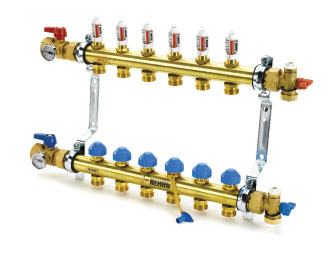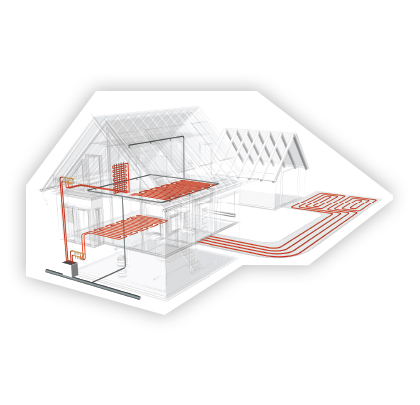Part 2: How Hydronic radiant floors are installed and how they work
A radiant floor system can provide comfortable, well-distributed heat, energy-efficiently and cost-effectively, if it is properly designed and installed. System components currently available make installation fairly easy. Proper design, however, is critical for a system that lives up to its promise.*

Image courtesy of Rehau Construction LLC
Design begins by determining how much heating capability is needed. The calculation is based on a desired interior temperature, the coldest predictable outside temperature at that location, and the rate at which heat is lost by the building. Then, the linear footage of tube needed to heat each space can be calculated. Tubes spaced closer together deliver more heat, so the desired heating capability is designed into the floor by controlling the spacing and pattern of the tube layout.
The section of tubing closest to the source is the hottest, and should be placed in the highest heat-loss areas, typically along exterior walls. A large room may require two circuits or more to heat it. Once the layout has been mapped, installation can begin. The boiler and distribution manifolds should be located as close to the center of the system as possible, to make it easier to balance the performance.
For a new construction slab on grade, the substrate must be properly compacted, and a 4-inch bed of gravel laid down. A moisture barrier is installed if required by groundwater conditions. No moisture or vapor barrier is normally required when using a foam nub-style PEX board. The perimeter foundation wall can be lined with a drainboard (or dimpleboard) up to the top of the finished concrete slab to allow moisture to seep down into the ground. A vertical liner of 1-inch foam insulation board is also advised to prevent heat-loss through the edge of the floor slab.
Then the PEX boards are laid out to cover the gravel. PEX board with interlocking flanges like the Amvic Insulated Radiant PEX Panel will automatically align the tube-paths and keep the assembly stable. The Amvic panels also accept tube sizes up to 1 inch, allowing another way to fine-tune heating capability for maximum efficiency.

Image courtesy of Amvic Building System
At this point, the hydronic system must be fully plumbed in and pressure tested. It’s the last chance before it’s permanently embedded in concrete. The system is purged of air. Then the flow-rate of each circuit can be adjusted separately at the manifold to balance the system. Once everything is checked and confirmed from a plumbing perspective, concrete can be poured.
If steel reinforcement is needed, wire-welded mesh (WWM) can be placed on top of the nubs. For commercial and other floors that need reinforcing bars, chairs can be placed on the nubs to position the rebar.
Most residential slabs require a minimum 3 inches of concrete. Commercial slabs with rebar need 4 inches or more, and often use 1-inch-diameter PEX tubing.
To retrofit a floor over an existing slab, the procedure is similar but prep is simpler. The existing concrete is cleaned, and the perimeter lined with 1-inch insulation board. PEX panels can be laid directly on the slab with no adhesive or attachment. Tubing installation is the same. Generally no reinforcement in the concrete is necessary.
Click here to see PART 1 of this article.
*A complete discussion of radiant floor system design is beyond the scope of this overview article. There are numerous online resources explaining it in detail, as well as expert consultants available.
■ ■ ■
[divider]
About the Author: Gary Brown is vice-president of marketing for Toronto-based Amvic Building System, a manufacturer of insulating concrete forms (ICFs) and rigid foam insulation. Including his 9 years at Amvic, he is a 24-year veteran of the energy-efficient, sustainable building industry. Brown can be reached at gbrown@amvicsystem.com.
Steven H. Miller, CDT, is an award-winning writer and photographer, and a marketing communications consultant specializing in issues of the construction industry. He can be contacted at steve@metaphorce.com.
Modern Contractor Solutions, June 2014
Did you enjoy this article?
Subscribe to the FREE Digital Edition of Modern Contractor Solutions Magazine!


